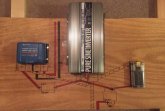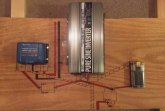winnyjstew
New Member
- Joined
- Nov 2, 2019
- Messages
- 22
I am a little confused on sizing the circuit breaker.
question 1: I have a 2000watt (12volt) inverter , I did the math for finding out the amperage of the inverter which is(2000/12v = 166 x 1.25 = 208.
what circuit breaker size should I get for connecting the inverter to the battery?
question 2. should I be using a bolt-on fuse AND a circuit breaker??
thanks
-Winston
question 1: I have a 2000watt (12volt) inverter , I did the math for finding out the amperage of the inverter which is(2000/12v = 166 x 1.25 = 208.
what circuit breaker size should I get for connecting the inverter to the battery?
question 2. should I be using a bolt-on fuse AND a circuit breaker??
thanks
-Winston





